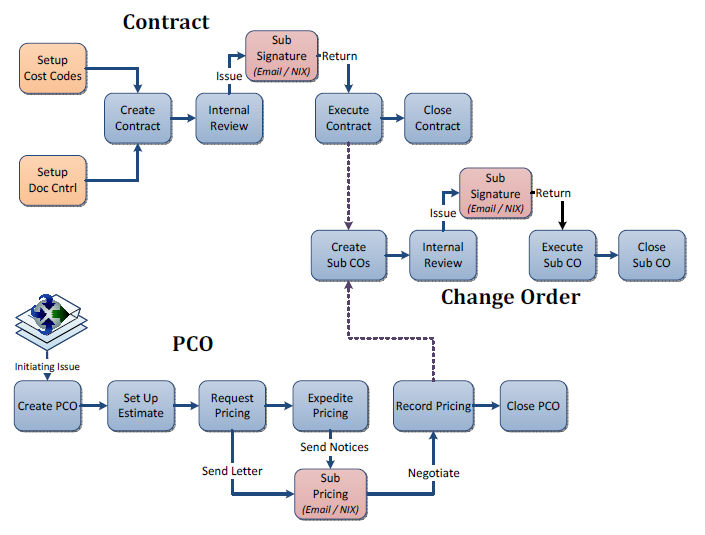Change Orders Overview
A change order (CO) is a signed written order legally amending a contract to affect a change in requirements, cost, or schedule to a previously negotiated contract. It incorporates changes previously negotiated by the owner and contractor through construction change directives and change order proposals. There are two types of COs: cost change orders and revenue change orders.
Cost change orders
Cost COs affect downstream contracts where the from contractor is paying the to contractor. Cost contracts may be subcontracts, purchase orders, or professional services agreements.
Revenue change orders
Revenue COs affect the upstream prime contract where the to contractor receives payment from the owner of the project. Some cost change orders may also be revenue change orders if the owner agrees to pay for the change.
Background
Depending on the terms of the prime contract, owner approval may be required on all cost change orders prior to giving any additional funds/time to subcontractors or suppliers. On other projects, the owner only reviews cost change orders that they will have to pay for through a revenue change order. A general contractor (GC) might have to issue a change order to a subcontractor (in order to keep project progress moving) prior to receiving official approval from the owner. In these cases, the GC is taking this action "at risk" and could end up having to absorb some or all of this cost change.
Pure cost change orders do not increase the total value of the project. Therefore, if the GC does not have contingency or an offsetting cost under-run, these change orders can reduce the GC's profitability.
Change orders usually result in adding funds to a contract due to increased scope of work to the contractor. However, change orders can also have a negative value if work is removed from the contract due to cancellation or transfer to another party. Occasionally, change orders will have zero monetary value. This is the case if the terms and conditions are changed which alter the legal relationship between contract parties, or if revised contract documents (drawings, specifications, exhibits) are added to the contractor's responsibility.
CO procedures are dictated by the contract. Some typical practices are:
● COs reference multiple construction change directives or change order proposals.
● COs may be written against subcontracts/purchase orders.
● To track contracts at a cost code level of detail, user must link potential change orders (PCOs) with the change order. A change order may include multiple pricing items from multiple PCOs.
● The party responsible for preparing the CO sends it out to be reviewed.
● The owner typically has final approval.
● Approved COs are distributed to the responsible parties.
Info Exchange support
Change orders can be reviewed and sent electronically through email or Info Exchange. From Info Exchange, external project team members can do the following:
● Answer change orders that were forwarded to them for a review.
● Manage open change orders assigned to them using the My Change Order Actions log.
● Download associated files and view them using the Newforma Web Viewer.
● Reference srelated items that were sent in the change order.
● Internal (Project Center) project team members can review and track change orders using the full Change Orders log in Info Exchange, enabling them to track the change order process via Info Exchange.
Your ability to view all change orders depends on your permission set assignment.
Commitments workflow

Related Topics
Table of Contents
Index
Search (English only)
Back





